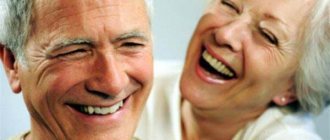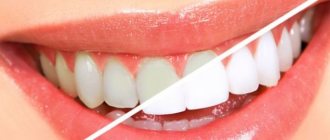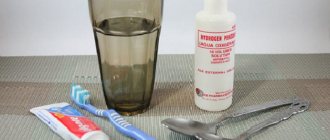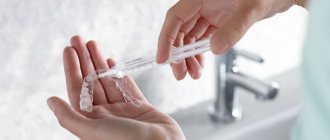Update date: 07/17/2020 15:13:23 6010 Share:
Author: Anastasia Berkovich
*Review of the best according to the editors of simplerule.ru. About the selection criteria. This material is subjective in nature, does not constitute advertising and does not serve as a purchase guide. Before purchasing, consultation with a specialist is required.
You can bleach laundry using hydrogen peroxide itself or with the addition of other products. Here's the basic way:
- Pour a bucket of warm water.
- Add hydrogen peroxide and mix well. For every liter of water you need to pour one teaspoon of the product.
- Place the laundry in the solution and leave for 20-30 minutes.
- Take the laundry out and run it under the tap for about a minute to rinse.
- Wring out the item and hang it to dry.
If stains remain on clothes after bleaching, they can be removed by combining hydrogen peroxide with baking soda. A solution of these two products helps to cope with stains no worse than factory stain removers. Follow these instructions exactly:
- Prepare a paste of baking soda and hydrogen peroxide. For 1 teaspoon of powder you will need 10 ml of product.
- Apply the mixture to the stains with a cotton pad and leave for 15 minutes.
- After processing, rinse the item well. The spots should disappear.
- Wring out the item and hang it to dry.
- If white curtains are not washed for a long time, they begin to turn gray under the influence of accumulating dust. To return them to their previous appearance:
- Pour 5 liters of warm water into a bucket or basin.
- Add a tablespoon of peroxide and a tablespoon of ammonia there.
- Soak the curtain in the solution and leave for half an hour.
- Rinse under running water.
- Wash your curtains as usual.
A solution of hydrogen peroxide, citric acid and soda ash will help deal with particularly difficult stains, such as greasy ones. Clean the item from excess contaminants and process as follows:
- Pour 2 liters of warm water into a bucket.
- Mix in it a teaspoon of hydrogen peroxide, a teaspoon of citric acid and a tablespoon of soda.
- Immerse your clothes in the resulting solution and leave for 15-20 minutes.
- Rub the stain. It should come off.
- Rinse the item thoroughly under water.
A mixture of hydrogen peroxide and dish soap also works well for oil and grease stains. This solution is easy to prepare and works well for cotton, but is not recommended for silk or wool:
- Pour 5 liters of warm water into a bucket.
- Add 2 tablespoons hydrogen peroxide and 1 tablespoon dish soap. Stir well.
- Immerse the laundry in the solution. Rub the stained area submerged in water to help the stain come off. Leave to soak for 15-20 minutes.
- After processing, rinse the item well. The spots should disappear.
- Wring out the item and hang it to dry.
You can also make your own stain remover using this recipe if there is no need to soak the entire item before washing. Simply mix peroxide and dish soap in the same ratio (the amount depends on how much solution you need). There are other recipes for hydrogen-based stain removers.
Things to consider
- Before bleaching, be sure to pay attention to the material of the product and the symbols on the label. It should indicate at what temperature the laundry can be washed. This is important because many of the methods below use boiling water. For example, synthetics cannot be cleaned in hot water, unlike linen and cotton fabrics.
- If the item is expensive and you are afraid to experiment, it is better to take it to the dry cleaner.
- If the chosen method did not help the first time, then after washing you can repeat the bleaching using the same or a different method.
Advantages and disadvantages of bleaching laundry with hydrogen peroxide
Benefits of bleaching white fabrics with hydrogen peroxide:
- low cost;
- removal of old plaque and yellowness;
- ease of use;
- preservation of the structure of the material;
- application for delicate fabrics;
- returning washed laundry to its original appearance;
- removing stains from deodorant, sweat and oil;
- availability of the drug.
The only downside to bleaching with hydrogen peroxide is the smell. Replace 1 tbsp. l. 3% peroxide can be 1 tablet of hydroperite. The effects of the drugs are the same.
Attention! The whitening effect is achieved by directly applying the product to the stain. The matter is saturated with oxygen, which breaks down the dirt.
Peroxide is a readily available antiseptic. The drug is sold in any pharmacy in the country. For bleaching, use a 3% peroxide solution. Usual composition concentration: 2 tbsp. l. drug per 10 liters of hot water.
We recommend reading: How to remove brilliant green from linoleum
How to bleach white clothes with commercial bleach
- What does it cope with? With almost everything: eliminates stains, yellowness, grayness and even helps restore color to faded items.
- What fabrics is it suitable for? Depends on the composition.
There are a large number of different bleaches, chlorine- and oxygen-containing, on store shelves.
Products with chlorine work, but can thin the fabric and ruin the color. They are used only for linen and cotton.
Therefore, it is better to give preference to oxygen bleaches. They are suitable for all fabrics, even delicate ones, and do not require high temperatures. This is important if the item cannot be washed in hot water.
How to use bleaches may vary, so follow the instructions on the package. Such products and brands as “Persol”, ACE, “BOS”, “Ushasty Nyan”, Vanish, Amway have proven themselves to be excellent.
Most often, things need to be soaked for several hours in water with bleach and washed. Or add the product directly to the washing machine along with the powder.
If the stains are strong and the fabric allows it, you can boil the laundry with bleach for at least 15 minutes and wash it in a machine.
Possibility of combination with other means
In addition to soda and hydrogen peroxide, other means are used to whiten things, which can be safely combined with the first two:
- table salt (suitable for synthetic fabrics, wool and silk);
- ammonia (cotton, linen, wool, silk, delicate fabrics);
- potassium permanganate (suitable for all types of fabric);
- mustard (suitable for all types of fabric).
You cannot add any professional bleaches (alkaline, chlorine, oxygen) to soda or hydrogen peroxide in order to enhance the effect of the former. This can lead to unforeseen consequences, such as yellowing or deterioration of the fabric.
How to bleach white clothes with a mixture of powder, bleach, oil and soda
- What does it cope with? This is a very effective way to combat yellowness and all kinds of stains. The product can remove even very old stains.
- What fabrics is it suitable for? For cotton and linen.
Pour 1 cup (250 ml volume) of laundry detergent, 4 tablespoons of good powder bleach and 1 tablespoon of baking soda into a saucepan. Pour in 4 tablespoons of sunflower oil.
Pour 10 liters of boiling water, stir and put dry things there. The quantity of necessary components can be changed, maintaining the proportions.
Place the pan on low heat for 15–20 minutes and stir the laundry occasionally. Remove from heat and let sit overnight or 6-8 hours. Then wash the items in the machine.
Precautions when bleaching clothes with hydrogen peroxide
When removing hydrogen peroxide stains on white things without protective equipment, you can get burned.
Burn on hand from hydrogen peroxide
There are precautions that must be followed:
- A paste of baking soda and hydrogen peroxide is applied to a white cloth for 10-15 minutes.
- Delicate items are soaked in warm water at a temperature of no more than 40 °C.
- Industrial bleaches are not added to hydrogen peroxide solutions. Combined use results in an undesirable chemical reaction, which may cause things to deteriorate or cause a fire.
- Rust stains on white clothes cannot be removed with peroxide.
- It is recommended to wear rubber gloves when mixing compounds to avoid getting burned.
- If the solution comes into contact with the eyes or mouth, a burn to the mucous membrane may occur. The affected areas are thoroughly washed with plenty of running water. If blisters begin to appear, immediately consult a doctor for qualified help.
- At home, it is not recommended to use a hydrogen peroxide solution of more than 3%.
- It is necessary to work with peroxide only in ventilated areas to avoid poisoning.
- In order not to spoil the clothes, first test the product on a piece of cloth or in an inconspicuous area.
Attention! Items should be completely immersed in the hydrogen peroxide solution. To avoid product color differences after surgery.
How to bleach white things with laundry soap and soda
- What does it cope with? This method is as effective as the previous one. It helps perfectly even with old stains and yellowness.
- What fabrics is it suitable for? For cotton and linen.
Place the laundry in a container with three liters of warm water. Rub each item thoroughly with laundry soap. Add 3 tablespoons of baking soda, stir and leave for several hours.
Place the pan over low heat and simmer for about 1 hour, stirring occasionally. The liquid will become colored as it absorbs contaminants.
Rinse the laundry in warm water. Do this until it comes out clean.
General information
About peroxide
Only a few of the possible ways to use peroxide were listed. However, peroxide is most often used in the household, for example, it effectively whitens laundry. This method is very affordable and economical for returning things to their former freshness and snow-whiteness.
Hydrogen peroxide. This drug has many useful qualities.
It is often used in medicine as a means to disinfect wounds, although it can also be used in other cases, such as:
— treatment of diseases of the ears and oral cavity;
— getting rid of mold and fungal infections;
- getting rid of skin blemishes;
- hair lightening, etc.
Pros and cons of this type of whitening
Hydrogen peroxide is universal; it is suitable for bleaching all fabrics. You can purchase this product at any pharmacy. Textile fibers are not damaged by such fabric bleaching. This method can also be used to bleach delicate items made of wool or silk. To bleach fabrics, you can only use a 3% peroxide solution, which is made by mixing 2 tbsp. l. ammonia and peroxide solution and 10 liters of water. Items that need to be bleached are soaked in the prepared solution for half an hour and then washed as usual.
REFERENCE! You can return things to their original appearance, which turns gray and fades with constant wear and frequent washing, using this method. It gets rid of traces of sweat, vegetable oil, and antiperspirant.
Pros of bleaching things with peroxide:
The whitening effect is achieved through the direct action of peroxide on stains, while it saturates the material with oxygen and breaks down dirt.
An analogue of peroxide is hydroperite in tablets. Instead of one spoon of peroxide, you will need one tablet of hydroperite. The action of these drugs is the same, but hydroperite differs in the presence of urea in the composition.
How to bleach white clothes with boric acid
- What does it cope with? A solution of boric acid is not able to remove yellowness. But it will rid things of grayness and return them to their former whiteness. For example, it will refresh old washed bed linen.
- What fabrics is it suitable for? For cotton and linen, as well as for synthetics, if it is not boiled.
Dissolve 2 tablespoons of boric acid in two liters of warm water. Leave the items in the mixture for 2 hours, stirring occasionally, and wash in the machine.
If the stains are old, boiling will help. To do this, place the container with things and the prepared solution on low heat. There is no need to soak the laundry. Boil for about 1 hour and throw in the washing machine.
Features of bleaching laundry with hydrogen peroxide
White clothes look noble. But maintaining her ideal appearance for as long as possible is quite difficult. Light-colored linen quickly washes out, acquires a yellow tint and loses its shine. The use of hydrogen peroxide to remove stains from fabrics is associated with some features:
- When restoring the material, do not mix dark and light underwear to avoid shedding.
- Old yellow stains from wool and silk are removed in several stages. Clothing is placed in a mixture of peroxide diluted with water. After 30 minutes, the product is drained, the laundry is washed and dried. If dirt remains, the procedure is carried out the required number of times until the color is restored.
- Removing yellow stains from cotton and linen is carried out by directly applying a peroxide solution to the material. If the yellowness remains, the procedure is repeated until the contamination disappears.
- Bleaching is carried out only once every 3-4 washes, otherwise the strength properties of the material will be lost.
- After bleaching, clothes are rinsed in 2 stages: first at a temperature of 20-40 ° C, and then in cold water.
Each type of matter has its own recipe for restoring whiteness. Therefore, when bleaching, things are separated not only by color, but also by type of fabric: synthetics, silk and wool, or cotton and linen.
Method number 6: “Whiteness”
If your white things have acquired a yellowish tint, then they are giving you a sign that it is time to use “Whiteness”. This product is suitable for lightening dense fabrics, but for thin tulle or delicate linen this bleach is dangerous. Let's learn to use Whiteness.
- Heat the water to a temperature of + 35 C.
- Pour 15 ml of “Belizna” into heated water.
- Add 20 g of washing powder.
- Immerse the laundry in the prepared solution and let it sit for 15 minutes.
That’s it, the laundry can be washed in a stylish machine in the “Fast 30” or “Rinse” mode. And another good folk remedy for whitening things involves boiling: add 15-20 ml of “Whiteness” and 20 g of washing powder to 4 liters of clean water, boil the laundry for 25 minutes. After boiling, the laundry is rinsed in plenty of clean water.
Cleaning medical gold
Medical gold is an alloy of brass, silver, copper, titanium and zinc, but there may be no gold in it at all: the alloy already has a noble “golden” luster. Products made from medical gold are durable, not subject to external mechanical influences, and due to the special technology of polishing and sputtering, they practically do not darken, do not lose shine, and do not change color.
- If it is necessary to clean such jewelry from contamination, the following methods are used:
- Rinse in a solution (2 drops of shampoo or liquid soap per 0.5 cup of water) and clean the product with a soft brush.
- To remove dust, wipe the product with a cotton swab soaked in beer; there is no need to rinse with water after this.
- Wipe the decoration with table vinegar, and then be sure to rinse in running water.
Get rid of bad breath.
Can't get rid of bad breath even after brushing your teeth? An excellent alternative for mouth rinsing is hydrogen peroxide. Since hydrogen peroxide kills bacteria that cause bad breath, all it takes is rinsing your mouth for 30 seconds. You'll be surprised how effective this is. But again, don't overdo it, and use a peroxide rinse once a week, as peroxide kills the good bacteria in your mouth too.
Using an Electrolyzer
This is done using a special electrolyzer device. It is a tube containing alkali. It also contains a pair of nickel electrodes. It is based on the principle of polarity. During operation, oxygen will be directed to that part of the pipe where the positively charged pole of the electrode is located, and hydrogen will tend in the opposite direction to the negative pole. This method of obtaining O2 and H2 is more suitable for laboratories. In addition, it is not designed for large volumes of gas production.










